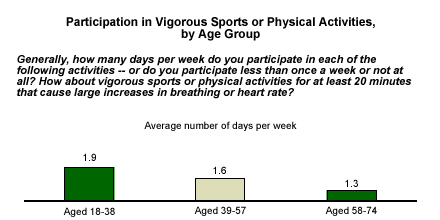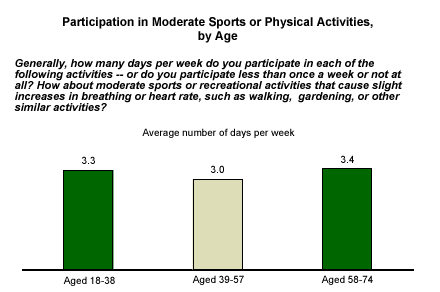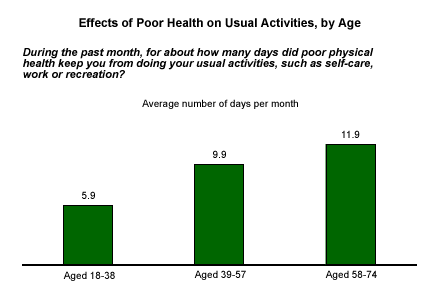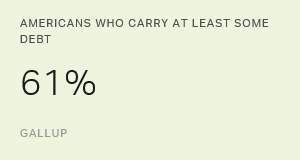Many baby boomers (adults currently between the ages of 39 and 57) are at the peaks of their careers. Looking ahead to retirement in a shaky economy may be inducing many in this age group to put in even more hours at work, and it may get harder and harder for baby boomers to hit the gym or go power-walking. That may be one reason why, according to Gallup data, boomers report engaging in moderate sports or recreational activities fewer days a week than those in the age groups below or above them.
Weight problems are particularly rampant among boomers (see "Majority of Boomers Say They're Overweight" in Related Items), but in this era of "quick-fix" diet drugs and liposuction, many baby boomers may not fully realize the dangers of being sedentary as their bodies age. The Online Journal of Issues in Nursing recently surveyed the literature on the role of exercise in preventing osteoporosis, heart disease, and even cognitive decline, and concluded that, "The inclusion of regular physical activity into our lives is the greatest weapon that we have against the onset of age-related disease and disability."
Work That Body
Aggregated data from Gallup healthcare surveys conducted between 2000 and 2002* allows a closer look at the responses of specific age groups to questions about various health behaviors. Grouping the responses of pre-boomer adults, baby boomers, and post-boomers shows that, as might be expected, the average number days per week in which respondents report participating in vigorous sports or physical activities declines with age.
But when it comes to moderate sports or recreational activities, the average number of days among boomers is somewhat below that of either their juniors or their seniors.


Physical activity is important for maintaining hardiness in the face of age effects. And it appears that many baby boomers could use a little extra hardiness; Gallup data indicate that boomers are likely to be waylaid for a significantly longer period of time when they are sick than younger adults are likely to be.
In looking at the average number of days in the past month that illnesses kept people from doing their usual activities, the average among boomers falls much closer to the average for 58- to 74-year-olds than that among those aged 18 to 38.

Bottom Line
On June 23, the American Heart Association, citing data from 44 different studies, issued a report urging doctors to prescribe exercise to their patients more often as way to lower the risk of heart disease and diabetes. There are a number of reasons why doctors may fail to work with their baby boomer patients on effective exercise regimens -- many may be less attuned to preventing disease than they are to treating it, for example, and doctors typically don't receive reimbursement from insurers for exercise training. But the AHA makes a compelling point: a stronger focus on exercise may be the best defense against a possible tidal wave of costs associated with age-related illnesses among baby boomers.
*Results based on an aggregate of telephone interviews with 2,006 American adults, aged 18 and older, conducted from 2000 through 2002. For results based on the total sample, one can say with 95% confidence that the maximum margin of sampling error is ±2.4%.
